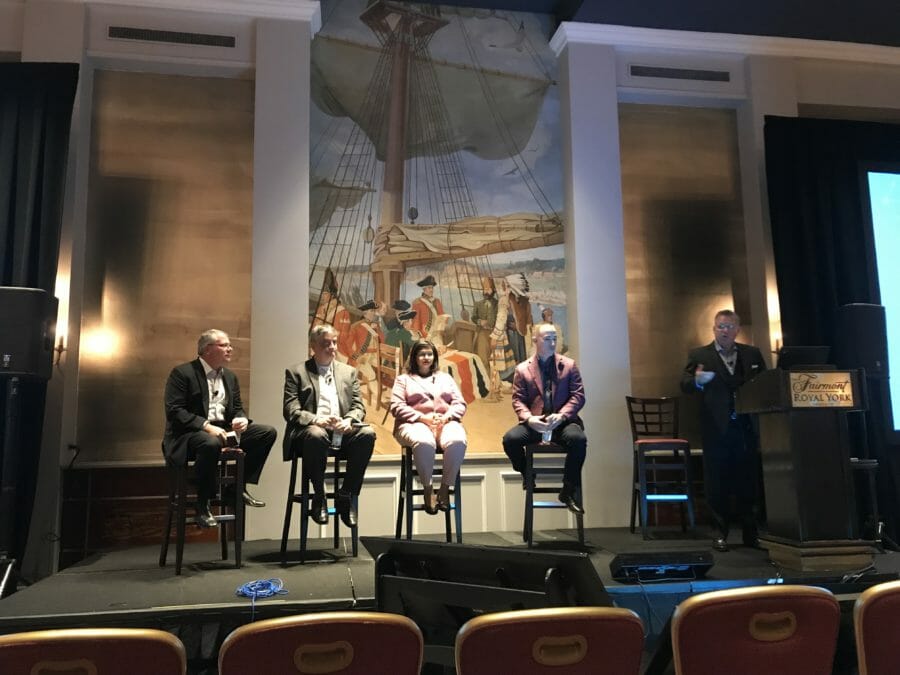The retail industry must now rely on advanced technologies to remain relevant, grow and reduce costs.
There are three key factors that have led to this necessary transformation of the sector:
1. E-commerce — this was a foreign and quite scary concept 10 years ago, but the instant nature of digital transactions is now a consumer requirement.
2. Data-driven decision-making — with digital comes data, and now retailers can use consumer data to predict buying habits, which is redefining the consumer experience both online and offline).
3. Mobile IoT — as more devices become connected, retailers can take advantage of more data to drive more value.
“These multi-channel experiences are reshaping and accelerating the retail ecosystem,” opened Michael Evans, account manager at SOTI during the retail innovation panel at SOTI Sync 2019.
Accelerate your business and change expectations — SOTI Sync 2019
Below, the four panelists explored four areas of retail innovation; how the sector has changed, what technologies are at play, the importance of mobility and the required areas of investment.
1. The most exciting time in retail
“It’s the most exciting time in retail,” according to Brian Clark, VP/GM Walmart Global Business, NCR.
“Customers are doing things they wouldn’t do five years ago and speed and time are the new currencies.”
What’s caused this shift? According to Clark, the race between Amazon and Walmart has catalysed the uptake of technology in the retail sector and that “it’s best thing for retail”, because it’s helping push everything at pace.
It’s got to the stage where retailers are adopting robotics ahead of proof-of-concepts and technology innovation is going to straight into the physical store.
Another change in the retail sector, indeed every industry, is the fact that IT is not a cost centre anymore. “It’s the tip of the spear and now business executives are technologists,” suggested Clark. “It’s a different game and now, the conversation is about how technology can produce outcomes.
It’s the consumer who wins the battle between physical and online
Shanthi Rajagopalan, Worldwide Retail and CPG strategy leader at Microsoft, agreed that nothing is the same in retail compared to what it was five years ago. “How people buy and consume is different,” she said. “Consumers are enabled by global platforms, they’re shopping on mobile devices and they’re influenced by platforms like Instagram.”
She also explained that how consumers think about receiving products has changed; online, pick up in store, buy in store, deliver etcetera, and retailers have to respond to this change.
Marco Nielsen, VP, Managed Mobility Services at Stratix, confirmed that customer experience has changed, “they want to be agile, but they need the right applications, he said.
While Brad Tracy, global retail segment leader at HP, concurred with his fellow panelist that this was indeed an exciting time in retail, he also claimed that “lots of retailers are scared and that they’re looking for guidance.”
He doesn’t buy into the retail apocalypse, that all physical stores are dead. Instead he is of the view that “stores will be more important than ever before as ways to showcase brands and engage with consumers…It’s a retail renaissance.”
Just like every other industry, retailers need to adapt to change, “otherwise they will go by the way of the dinosaurs,” according to Tracy. “They need to adopt an innovation mindset, and they need to be prepared to fail fast and experiment.”

2. Retail innovation
Moving onto retail innovation, Tracy explained that there are four trends that have created the need to accelerate and innovate: mass urbanisation, which has changed the dynamics of retail, changing demographics, which has led to a change in products, globalisation, how can retailers respond to the world getting smaller and most importantly, accelerated innovation — “the number of devices is growing exponentially and when you combine that with 5G, the opportunities are going to be many and it’s going to be critical that these devices are managed,” he said.
Clark agreed that 5G will play an important role in the transformation of retail, but it’s what’s going on behind the scenes that excites him.
He said: “Retail was not a sexy place to work in, but now with the theme of tech getting behind the scenes, that’s changed. Autonomous processes and automation is changing what the workforce does.
“The workforce can engage with tech and not focus on mundane tasks like unloading trucks or cleaning floors.”
To embrace this innovation, stores must be able to respond to this technology and evolve, and Nielsen saw this as essential; “retailers need tech in stores that functions at all times,” he said.
Rajagopalan, perhaps unsurprisingly given her role at Microsoft, pointed to the cloud as the innovation that’s allowing all of the above things to happen.
“The power of cloud,” she said, “allows devices to be connected and it gives consumer the opportunity of single, cross-channel experience.”
She pondered how much better is cloud going to get, especially considering things like edge computing, where information can be analysed in real-time.
The convergence of technology, especially mobility, must be secured
3. Mobility
“Mobility is transforming retail,” said Nielsen as the panel moved into the third area of discussion.
Employees, again like in any other sector, expect a familiar device to work on and “unless retailers are supporting and investing in mobility [the new ways of working and communicating], they’ll be in trouble.”
He did note that they are “still making choices on which platforms and which devices to use to create a seamless experience for both employees and customers”.
Clark explained that he sees mobility as an “opportunity to enable people who don’t have traditional forms of payment,” those without bank accounts (but with mobile phones), for example, to be able to purchase goods and services.
Following this, Rajagopalan made the point that mobility might not be just represented in the hand with a device. Instead, “it might be in the ear, or in front of your eyes with virtual reality”.
Concluding this section, Tracy emphasised the importance mobility is having on retail — “it’s improving sales success rates and directly impacting the bottom line by creating a better customer experience,” he said.
The keys to becoming a successful retail innovator
4. Areas for investment
Clark pointed to automation and computer vision as the two main areas that retailers are investing in and explained that they should continue to do so.
Computer vision, in particular, has many applications; “it could be used to create biometric identity solutions for the purchase alcohol, for example.
Rajagopalan suggested that investment should be focused on digitising physical stores. “They must be able to get data out of the physical,” she said.
“Digital natives can collect the digital signal at every step of the customer journey and use AI/ML to identify patterns.”
So the question arises, how do stores get data to unlock opportunities for optimisation? Traditional retailers aren’t built like digital natives, so they must employ partners “like SOTI who can them evolve with technology in an agile way, which is necessary to compete with disruption,” Rajagopalan continued.
The key is agility
In concluding the panel, Tracy said that for retailers the “key is agility”.
The ability to move fast and accelerate is important, but historically retail hasn’t done this. Moving forward, the industry needs to adopt new tech and adapt to the customer, the employee and the world.







